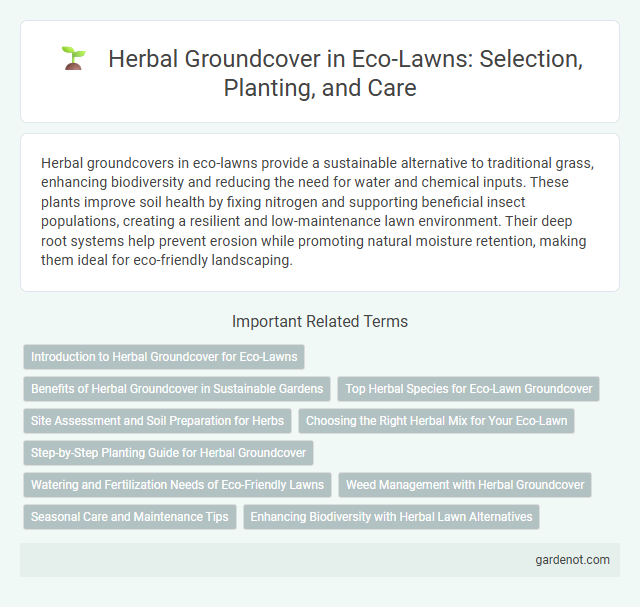Herbal groundcovers in eco-lawns provide a sustainable alternative to traditional grass, enhancing biodiversity and reducing the need for water and chemical inputs. These plants improve soil health by fixing nitrogen and supporting beneficial insect populations, creating a resilient and low-maintenance lawn environment. Their deep root systems help prevent erosion while promoting natural moisture retention, making them ideal for eco-friendly landscaping.
Introduction to Herbal Groundcover for Eco-Lawns
Herbal groundcovers for eco-lawns offer a sustainable alternative to traditional grass by enhancing biodiversity and improving soil health. These low-maintenance plants, such as clover, chamomile, and thyme, require less water and fertilizer while attracting pollinators like bees and butterflies. Integrating herbal groundcovers into eco-lawns supports carbon sequestration and reduces urban heat island effects, promoting environmentally friendly landscaping.
Benefits of Herbal Groundcover in Sustainable Gardens
Herbal groundcovers promote soil health by naturally enhancing nutrient cycles and improving water retention, reducing the need for synthetic fertilizers and irrigation. These plants support biodiversity by attracting pollinators and beneficial insects, contributing to balanced ecosystems in sustainable gardens. Their low-maintenance growth habit minimizes weed invasion and erosion, making them ideal for eco-friendly landscaping solutions.
Top Herbal Species for Eco-Lawn Groundcover
Thyme, chamomile, and clover are top herbal species ideal for eco-lawn groundcover due to their low water requirements and natural pest resistance. These herbs improve soil health by fixing nitrogen and support pollinators with their fragrant flowers. Their durability and drought tolerance make them sustainable alternatives to traditional turfgrass.
Site Assessment and Soil Preparation for Herbs
Site assessment for herbal groundcover in eco-lawns involves evaluating soil pH, drainage, sunlight exposure, and existing vegetation to select suitable herb species such as thyme, chamomile, or oregano. Proper soil preparation includes loosening the soil, incorporating organic matter like compost to improve fertility and structure, and adjusting pH levels to optimize herb growth. Ensuring well-drained, nutrient-rich soil supports resilient herbal groundcover that enhances biodiversity and sustainable lawn management.
Choosing the Right Herbal Mix for Your Eco-Lawn
Selecting the right herbal mix for your eco-lawn involves considering climate adaptability, soil type, and maintenance requirements to ensure sustainability and resilience. Popular choices include clover, thyme, chamomile, and creeping sedum, which provide drought tolerance, low mowing needs, and attract pollinators. Tailoring the herbal groundcover mix to local environmental conditions promotes biodiversity, reduces water use, and minimizes the need for chemical inputs.
Step-by-Step Planting Guide for Herbal Groundcover
Prepare the soil by removing weeds and loosening the top 4-6 inches to ensure optimal root growth for herbal groundcover. Sow seeds or plant cuttings evenly, maintaining recommended spacing of 6-12 inches depending on the herb species to promote healthy spread and coverage. Water gently but thoroughly after planting, and maintain consistent moisture during the first 4-6 weeks to establish strong roots and prevent drought stress.
Watering and Fertilization Needs of Eco-Friendly Lawns
Herbal groundcovers in eco-lawns require minimal watering due to their deep root systems, which enhance drought tolerance and reduce water consumption by up to 50% compared to traditional turfgrass. Fertilization needs are low, with organic compost or slow-release, eco-friendly fertilizers supporting soil health and promoting sustainable growth. These practices optimize water efficiency and nutrient uptake, contributing to an environmentally responsible lawn care strategy.
Weed Management with Herbal Groundcover
Herbal groundcovers such as clover, thyme, and chamomile provide effective weed management by shading soil and suppressing weed seed germination in eco-lawns. These low-maintenance plants improve soil health through nitrogen fixation while creating dense mats that limit space and resources available to invasive weeds. Incorporating herbal groundcovers reduces reliance on chemical herbicides, promoting sustainable, environmentally friendly weed control methods.
Seasonal Care and Maintenance Tips
Herbal groundcovers thrive with seasonal care that includes regular watering during dry periods and occasional pruning to promote healthy growth. Mulching around the plants helps retain moisture and suppress weeds, essential for maintaining soil health and preventing erosion. Fertilizing in early spring with organic compost boosts nutrient levels, ensuring vibrant groundcover throughout the growing season.
Enhancing Biodiversity with Herbal Lawn Alternatives
Herbal groundcovers in eco-lawns significantly enhance biodiversity by providing diverse habitats for pollinators, insects, and soil microorganisms. These herbal lawn alternatives, consisting of species such as clover, thyme, and yarrow, improve soil health through nitrogen fixation and attract beneficial wildlife. Integrating herbal species promotes a resilient ecosystem, reducing dependency on chemical inputs and supporting sustainable landscape management.
Herbal groundcover Infographic

 gardenot.com
gardenot.com